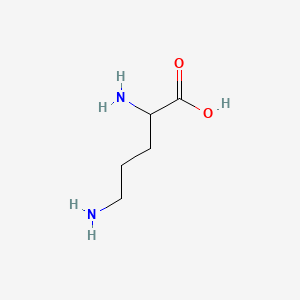| MeSH term | MeSH ID | Detail |
|---|---|---|
| Uremia | D014511 | 33 associated lipids |
| Stomach Ulcer | D013276 | 75 associated lipids |
| Kidney Failure, Chronic | D007676 | 51 associated lipids |
| Diabetes Mellitus | D003920 | 90 associated lipids |
| Adenocarcinoma | D000230 | 166 associated lipids |
| Lupus Erythematosus, Systemic | D008180 | 43 associated lipids |
| Lung Neoplasms | D008175 | 171 associated lipids |
| Wounds and Injuries | D014947 | 20 associated lipids |
| Burns | D002056 | 34 associated lipids |
| Adenoma, Islet Cell | D007516 | 7 associated lipids |
2,5-diaminopentanoic acid
2,5-diaminopentanoic acid is a lipid of Fatty Acyls (FA) class. The involved functions are known as Vasodilation, Intestinal Absorption and Pinocytosis. 2,5-diaminopentanoic acid often locates in Mitochondria, Microfilaments, NADH dehydrogenase complex and respiratory chain complex III location sensu Eukarya. The associated genes with 2,5-diaminopentanoic acid are GAPDH gene and iberiotoxin.
Cross Reference
Introduction
To understand associated biological information of 2,5-diaminopentanoic acid, we collected biological information of abnormalities, associated pathways, cellular/molecular locations, biological functions, related genes/proteins, lipids and common seen animal/experimental models with organized paragraphs from literatures.
What diseases are associated with 2,5-diaminopentanoic acid?
There are no associated biomedical information in the current reference collection.
Possible diseases from mapped MeSH terms on references
We collected disease MeSH terms mapped to the references associated with 2,5-diaminopentanoic acid
PubChem Associated disorders and diseases
What pathways are associated with 2,5-diaminopentanoic acid
There are no associated biomedical information in the current reference collection.
PubChem Biomolecular Interactions and Pathways
Link to PubChem Biomolecular Interactions and PathwaysWhat cellular locations are associated with 2,5-diaminopentanoic acid?
Visualization in cellular structure
Associated locations are in red color. Not associated locations are in black.
Related references are published most in these journals:
| Location | Cross reference | Weighted score | Related literatures |
|---|
What functions are associated with 2,5-diaminopentanoic acid?
Related references are published most in these journals:
| Function | Cross reference | Weighted score | Related literatures |
|---|
What lipids are associated with 2,5-diaminopentanoic acid?
There are no associated biomedical information in the current reference collection.
What genes are associated with 2,5-diaminopentanoic acid?
Related references are published most in these journals:
| Gene | Cross reference | Weighted score | Related literatures |
|---|
What common seen animal models are associated with 2,5-diaminopentanoic acid?
There are no associated biomedical information in the current reference collection.
NCBI Entrez Crosslinks
All references with 2,5-diaminopentanoic acid
Download all related citations| Authors | Title | Published | Journal | PubMed Link |
|---|---|---|---|---|
| Papadaki G et al. | Neutrophil extracellular traps exacerbate Th1-mediated autoimmune responses in rheumatoid arthritis by promoting DC maturation. | 2016 | Eur. J. Immunol. | pmid:27585946 |
| Gomig F et al. | Quinolone resistance and ornithine decarboxylation activity in lactose-negative Escherichia coli. | 2015 Jul-Sep | Braz. J. Microbiol. | pmid:26413057 |
| Scott JA et al. | Plasma arginine metabolites reflect airway dysfunction in a murine model of allergic airway inflammation. | 2015 | J. Appl. Physiol. | pmid:25979935 |
| Ballantyne LL et al. | Strategies to rescue the consequences of inducible arginase-1 deficiency in mice. | 2015 | PLoS ONE | pmid:25938595 |
| Renga B et al. | Cystathionine γ-lyase, a H2S-generating enzyme, is a GPBAR1-regulated gene and contributes to vasodilation caused by secondary bile acids. | 2015 | Am. J. Physiol. Heart Circ. Physiol. | pmid:25934094 |
| Escobedo-Hinojosa WI et al. | OlsG (Sinac_1600) Is an Ornithine Lipid N-Methyltransferase from the Planctomycete Singulisphaera acidiphila. | 2015 | J. Biol. Chem. | pmid:25925947 |
| Bizjak DA et al. | Increase in Red Blood Cell-Nitric Oxide Synthase Dependent Nitric Oxide Production during Red Blood Cell Aging in Health and Disease: A Study on Age Dependent Changes of Rheologic and Enzymatic Properties in Red Blood Cells. | 2015 | PLoS ONE | pmid:25902315 |
| Martinelli D et al. | The hyperornithinemia-hyperammonemia-homocitrullinuria syndrome. | 2015 | Orphanet J Rare Dis | pmid:25874378 |
| Kao CC et al. | Indian women of childbearing age do not metabolically conserve arginine as do American and Jamaican women. | 2015 | J. Nutr. | pmid:25833892 |
| Šišková P et al. | Phenotypes of Escherichia coli isolated from urine: Differences between extended-spectrum β-lactamase producers and sensitive strains. | 2015 | J Microbiol Immunol Infect | pmid:24865414 |
